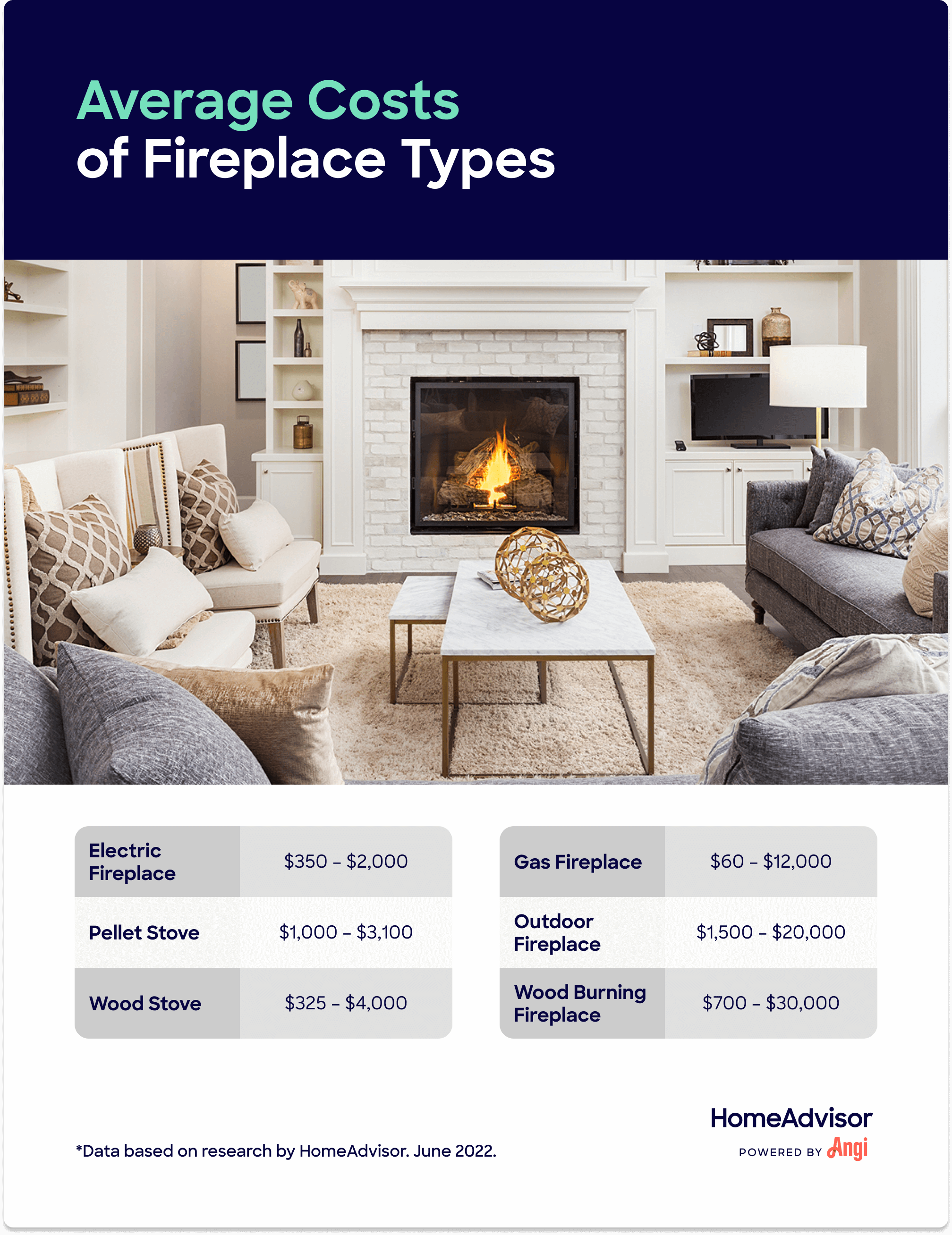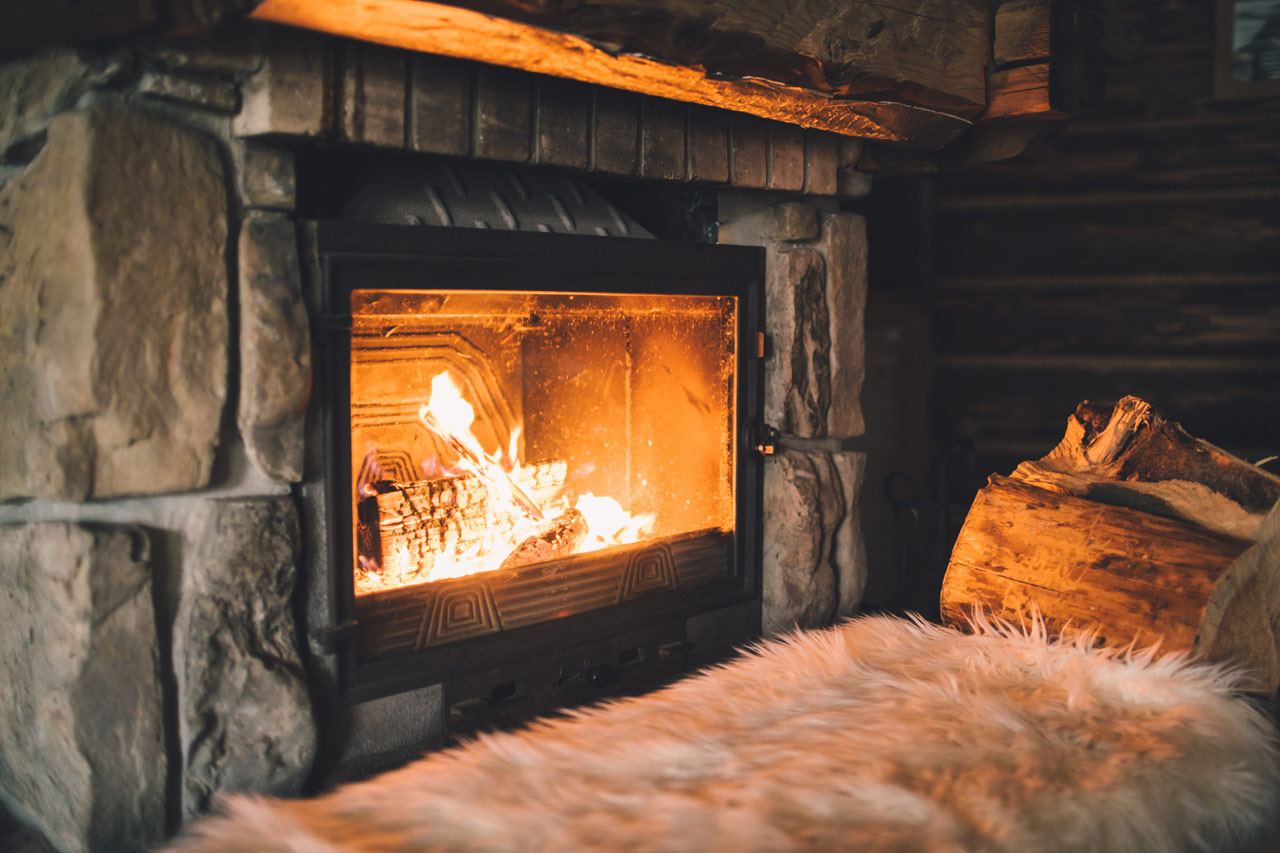How Much Does It Cost to Install a Fireplace or Wood Stove?
Typical Range:
$945 - $4,200
Typical Range:
$945 - $4,200
Cost data is based on actual project costs as reported by 1,590 HomeAdvisor members. Embed this data
.
.
.
.
.
.
.
.
.
.
.
.
.
.
.
.
.
.
.
.
.
.
.
.
.
.
.
.
.
.
•
•
•
•
Updated July 25, 2022
Reviewed by Robert Tschudi, Expert Home Building and Remodeling Contributor.A fireplace doesn’t just make your home cozy when temperatures start to dip in the winter. It also adds some value. The cost to install a fireplace or wood stove is typically between $945 and $4,200. The average homeowner pays around $2,498, but this varies widely depending on the required work. A portable electric fireplace could cost as little as $150, but building an intricate masonry wood-burning fireplace requiring chimney installation could cost more than $30,000.
Let's calculate cost data for you. Where are you located?
Where are you located?
| National Average | $2,498 |
| Typical Range | $945 - $4,200 |
| Low End - High End | $150 - $8,700 |
Cost data is based on actual project costs as reported by 1,590 HomeAdvisor members.
The type of fireplace or stove will help determine your project’s overall price—and those that need ventilation will be pricier to install depending on your existing home setup.
| Type of Fireplace | Typical Price Range, Installed |
|---|---|
| Wood-Burning Fireplace | $700 – $30,000 |
| Wood Stove | $325 – $4,000 |
| Electric Fireplace | $350 – $2,300 |
| Gas Fireplace | $60 – $12,000 |
| Outdoor Fireplaces | $1,500 – $20,000 |
| Pellet Stove | $1,000 – $3,100 |
In a home with adequate ventilation and a working chimney, you could install a wood-burning fireplace for as little as $700. Constructing a brand new wood-burning fireplace from scratch could run more than $30,000. This fireplace type is the most traditional, but it has the largest range of potential project prices. Things that increase the cost include:
Masonry work
Chimney and flue installation
Foundational work to support the weight of the fireplace
Removal of existing fireplace
The cost to install a wood stove ranges from $325 to $4,000 or more. You can purchase a free-standing unit for less than $1,500. But wood stoves are freestanding and require ventilation and non-combustible wall coverings on nearby walls. This bumps up the price, more commonly, to the $3,000 to $4,000 range.
Catalytic wood stoves produce fewer fumes and burn more efficiently, which are more expensive than non-catalytic stoves.
Most people spend anywhere from $250 to $2,000 on their electric fireplace, plus an additional $150 to $300 for professional installation. Wiring can add $140 to $200 or more to the project. Electric fireplaces are highly efficient and carry a very low safety risk compared to traditional wood or gas fireplaces.
The cost to install a gas fireplace ranges from $60 to $12,500. A small tabletop unit can cost as little as $60, while a built-in gas fireplace can cost more than $9,000. If you need to install a gas line, it could add $120 to $1,350 to your project.
The cost to build an outdoor fireplace can range from $1,500 to more than $20,000—this does not include custom fireplaces with ornate designs. The price increases as the work required grows. A pre-made kit or unfinished contractor model is the most budget-friendly.
The cost to install a pellet stove is typically between $1,000 and $3,100. Pellet stoves are similar to wood-burning stoves, but they burn clean pellet fuel instead of wood and use a thermostat to control temperature.
The cost of fireplace inserts is usually between $700 and $6,500, including parts and labor, but it depends on the insert type. Labor costs vary based on how the insert is powered. A local fireplace insert professional can give you a more accurate estimate.
Fireplace inserts are wood or gas stoves designed to fit into an existing masonry fireplace. You might choose this over a traditional wood-burning option if you’re looking for an affordable and efficient fireplace.
| Fireplace Insert | Average Insert Cost | Installation Costs (Labor Only) | Total Project Cost |
|---|---|---|---|
| Wood | $800 – $4,500 | $2,180 | $3,080 – $6,680 |
| Gas | $800 – $4,500 | $1,500 | $2,300 – $6,000 |
| Pellets | $1,500 – $5,000 | $525 | $2,025 – $5,525 |
| Electric | $200 – $1,500 | $225 | $425 – $1,725 |
Since the project cost will rise if you need chimney repairs, enlist a local chimney inspection service before installing a fireplace insert that uses a chimney for ventilation.
You can make the switch with a modest budget—especially if you already have a chimney flue. Most homeowners spend between $100 and $300 to convert a gas fireplace into a wood-burning fireplace—but conversion isn’t possible without a flue. In addition, you may need extra masonry work, repairs to your fireplace facade, or chimney construction or replacement, which can add significant expenses. Here are some potential costs to convert a gas fireplace to wood:
Cost to build a chimney: $900–$3,000 for a 15-foot chimney
Cost to install chimney liner or flue: $625–$7,000
Cost of masonry work: $40–$75 per hour for labor
Cost to repair fireplace: $177–$933
This project budget varies widely based on a number of influential factors. Constructing a fireplace in a new home that never intended to have a fireplace will jack up your prices significantly, as will your style and ventilation needs.
To save money on your new build, build and install your fireplace during the construction phase. Outfitting a home never intended for a wood-burning or gas fireplace comes with significant challenges. Your contractor will complete additional chimney construction, ductwork, or electrical work. In this case, a ventless or electric fireplace may be your most cost-effective option.
The type and style of your fireplace will be your biggest cost factor. Electric and ventless gas styles don’t require ventilation, which can save you thousands. Others involve complicated masonry, gas line installation, or additional wiring that will increase labor costs.
Consider your material choices, too. For example, the cost of a stone veneer fireplace is always less than the cost of natural stone. If you choose a wood-burning fireplace or stove, factor in the ongoing cost of firewood.
Ventilation is crucial for fireplace safety. If you need to add ventilation or fix your existing source of ventilation, you may have to bump your budget by thousands. Most homeowners spend $65 to $350 per square foot to build a chimney, and the typical price of a chimney rebuild ranges from $1,000 to $5,000. A chimney exhaust fan alone costs between $2,240 to $4,150.
The cost to install a chimney liner is typically between $625 to $7,000. The average homeowner pays $2,500. Clay and aluminum are the most cost-effective flue liners compared to pricier options like ceramic or thermocrete.
The typical prefabricated gas or wood-burning fireplace costs $2,000 to $6,000, while a custom fireplace typically costs $4,000 to more than $8,000. Pre-fab gas fireplaces are self-contained boxes that take a contractor minimal time to install in an existing fireplace, making them a common, cost-effective option.
We know and love fireplaces for their heating properties and charm. Obvious downsides to fireplaces are their costs and the safety hazards associated with them—especially the safety of ventless gas fireplaces. Beyond that, chimney-vented fireplaces become hazardous if not properly vented and maintained.
According to the National Fire Protection Association, heating equipment like fireplaces and wood-burning stoves is a top cause of residential fires. Failure to clean chimneys is a major contributor. Don’t skip your annual inspection, and call a chimney sweeper near you when cleanings are required.
Aside from safety, here are a few pros and cons of each type of fireplace.
| Type of Fireplace | Pros | Cons |
|---|---|---|
| Wood-Burning | Lower utility expenses and pleasant ambiance | Installation can be expensive and requires more maintenance |
| Gas | Easy to use and suitable for homes without a chimney or flue | Higher utility bill from gas usage and ventless options are a potential safety hazard |
| Electric | No mess, no flames, no harmful emissions, and no chimney or flue required | May not look realistic, requires wiring installation, and increases utility bills |
Pleasant ambiance aside, they also add value to your home.. In a 2016 Angi survey, 77% of buyers revealed that they would pay $1,000 to $5,000 more for a home with a fireplace. In other words, installation could pay for itself, but you’re not likely to see a favorable return on investment if you go with a pricey custom fireplace.
You can buy a portable electric or gas stove, but fireplace installation is a job best left to a pro. It’s not just about safety and insurance; it’s about local laws, building codes, and regulations, too. For example, some states have banned ventless fireplaces because of health concerns, and others have specific legal requirements for fireplace safety. You can save some money by DIYing a fireplace surround update, but leave the actual installation to a fireplace contractor near you.
Some cities like New York City ban wood-burning fireplaces. Colorado and the California Bay Area have laws about when you can and cannot use your wood-burning fireplace based on air quality. Since every area has different requirements for wood-burning fireplaces, it’s best to consult a local contractor who has experience in your area. The Environmental Protection Agency (EPA) lists a starter guide to some state ordinances and regulations.
You can build a fireplace in an existing house—though some local ordinances or HOA rules may prevent wood-burning options. Building a fireplace in an existing house often requires significant work (like building a chimney), which may be cost-prohibitive. In that case, an electric option may be your best bet.
According to the National Association of Home Builders (NAHB), fireplaces are no longer one of the top five most-wanted home features, but they can still add value to your home. Still, Redfin found homes with fireplaces are priced 13% higher than the national median sale price.
Due to the risk of an accidental house fire, having a fireplace or wood-burning stove in your home can increase your home insurance premium. You may even need to add specific fireplace coverage, which could be voided without specific proof of maintenance. Discuss options with your insurance agent before you install a fireplace.
A fireplace insert is a fireproof box made of metal and insulated glass, similar to a freestanding heating stove. The difference is that it will fit directly inside your existing fireplace. Traditional fireplaces use an open combustion system that loses heat through the chimney. Inserts are more efficient because they use a closed combustion system.

